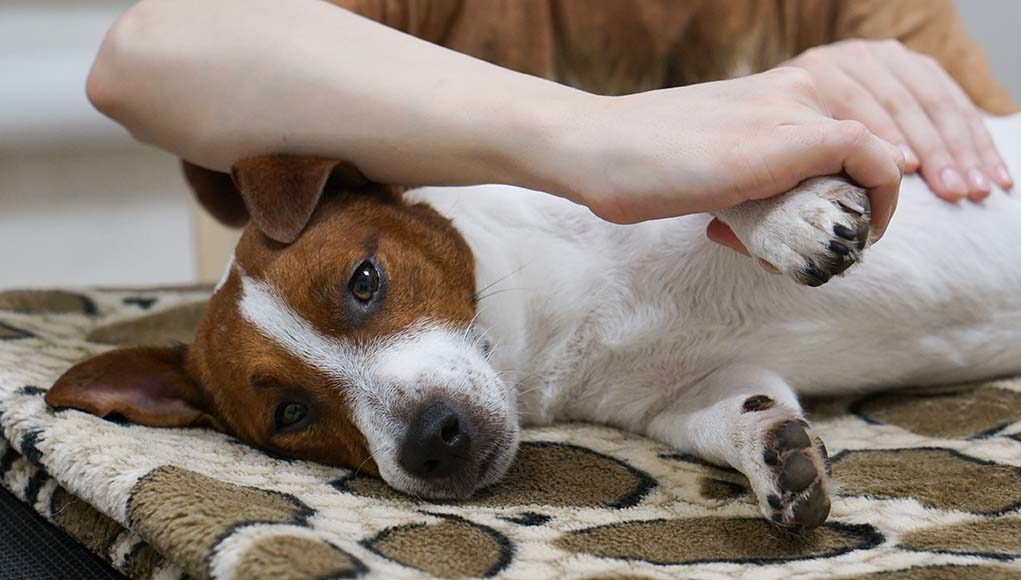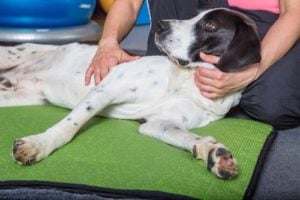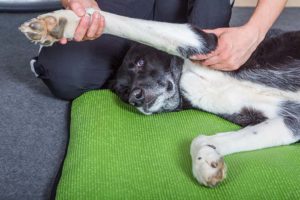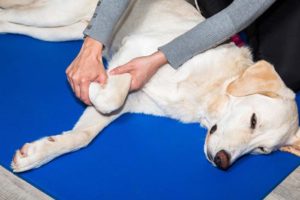Do you suspect your dog suffering from arthritis? Do you see your dog experiencing discomfort and you feel helpless about your dog in pain? On top of the standard vet approved treatment and arthritis diet and supplements, a dog arthritis massage can provide some relief.
Table of Contents
In this article we will discuss:
- What is arthritis and how does it affect dogs?
- How can you help a dog with arthritis?
- What is canine massage and why is it so good for your dog?
- How to massage your own dog at home
What Is Arthritis and How Does It Affect Dogs?
Arthritis affects the tissues around the dog's joints and other connective tissues, causing inflammation. It is a rheumatic and degenerative disease that causes soreness, with the pain getting worse over time.
Arthritis happens when the layer of normally smooth cartilage, which covers the bone surface inside of the joints, becomes damaged, leaving the bone surfaces to rub together. This friction is what causes the pain and discomfort. The stiffness is a result of new bone forming around the joint, limiting movement.
Arthritis is very common in dogs. The main areas that are affected in dogs are their hips and lower spine, their knees, and sometimes the elbows and shoulders, although less severely. This is a disease that is seen more commonly in older dogs, but it can happen to a dog of any age.
The signs of arthritis in dogs are pain, discomfort and stiffness, although these can sometimes be too subtle to notice at first. Typical clues are seeing your dog licking a spot where there is a joint despite there being no visible problem or swelling, and observing a dog slowing down and becoming less active.
How Can You Help a Dog With Arthritis?
Arthritis is worse in dogs that are overweight or unfit, so the first thing to do is put them on fat loss plan, reassess their meal portions and ensure adequate daily exercise. This will take extra weight and pressure off the dog's joints, improve range of movement and flexibility, including improvement of the fitness of the muscles that support the joints.
You can also provide pet ramps and pet steps to help your dog get up and down from raised surfaces without putting extra strain on their joints. These are especially useful for helping your dog to get in and out of your bed or car.
If a veterinarian diagnoses your dog with arthritis, they will often recommend short-term anti-inflammatory therapy or give long-term drug therapy for pain relief. The type of drug you should expect from your vet is non-steroidal anti-inflammatory (NSAIDs).
Another great way that you can help to relief your dog’s arthritis pain is with home dog arthritis massage
What Is Dog Arthritis Massage?
Canine massage is a type of massage for dogs specifically (different to human massage) and there are several types. You can massage your own dog at home, helping them to relax their muscles, de-stress, lower their blood pressure, and either wind down for the evening or prepare for the day ahead.
Massaging a dog is also a great therapeutic exercise for you. It is meditative, mindful, and good for stress relief in people. It is also the perfect opportunity to check your dog all over for any hidden lumps and bumps, fleas, cuts and sores. Regular canine massage helps you to know what is going on with your pet, and to quickly recognize when something has changed and may need attention.
Massage won’t cure your dog of arthritis, but it will provide temporary relief. When your dog experiences soreness in their joints, they naturally overcompensate by using other muscles in the body. These muscles then bear the extra weight and work in a way that they are not intended for, and this can cause them to become strained. When you massage your dog, you help to relax these muscles, improving blood flow to the tissues and arthritic joints. Dog arthritis massage also helps to reduce muscle spasms.
How to Give a Dog Arthritis Massage
It is important to be aware that any dog that is suffering from soreness or pain should be approached with care and caution. You should take a slow approach to massaging a dog that may not be used to it and does not know what to expect. If your dog is in pain they may also be grumpy and unpredictable, so you should build trust for them to relax and benefit from the massage.
Many dogs that suffer from arthritis are older dogs, and they may be experiencing other ailments that come along with age (for example, deafness, blindness or senility). If this sounds like your dog then you should keep this in mind and take extra care and caution when massaging the pet.
A great time to massage a dog is in the morning and evening. A morning dog massage can help to relieve the stiffness that occurs overnight, and an evening massage can deal with any strains or sore muscles resulting from activity during the day.
Position your dog in a comfortable position where you can have free access to his body. Laying the dog on their side is perfect as half way through your session you can roll them over to work on the other side of the body.
The first step is to get your dog accustomed to being touched, stroked and petted in the lying down position. You can do this simply by running your hands all over your dog’s body, and talking to them in a soothing, calming voice.
Next, pay attention to any areas where the muscles feel tight. You can stroke these areas too, building up with slightly increased pressure. It is important not to massage over arthritic joints, as this will be uncomfortable for your dog. Instead begin to knead larger muscle groups on the shoulders and haunches.
Be careful not to overwork any one area. You can avoid this by continuously moving your hands from one area to the next. If you feel your dog resisting or if he winces, whines or nips and licks at your hands, it is probably a sign that they are experiencing discomfort in that area, or that they want to stop.
You should alternate between kneading and stroking, and varying the pressure when it comes to the larger muscles.
At the end of the dog arthritis massage session you should give your pooch praise and treats to reinforce the activity as being something positive and enjoyable that your dog will look forward to next time.
Conclusion
Canine arthritis massage is a great way to bond with your dog and develop even more trust, helping your dog to feel better, and relieving the pain and discomfort that arthritis causes. The key is to take it slowly, and not to push your dog into doing anything he doesn’t want to do.
The more regularly you practice massage with your dog, the more relaxed and compliant your dog will become, especially when he realized what a rewarding experience dog massage is.
READ NEXT: The Best Dog Massage Videos
















